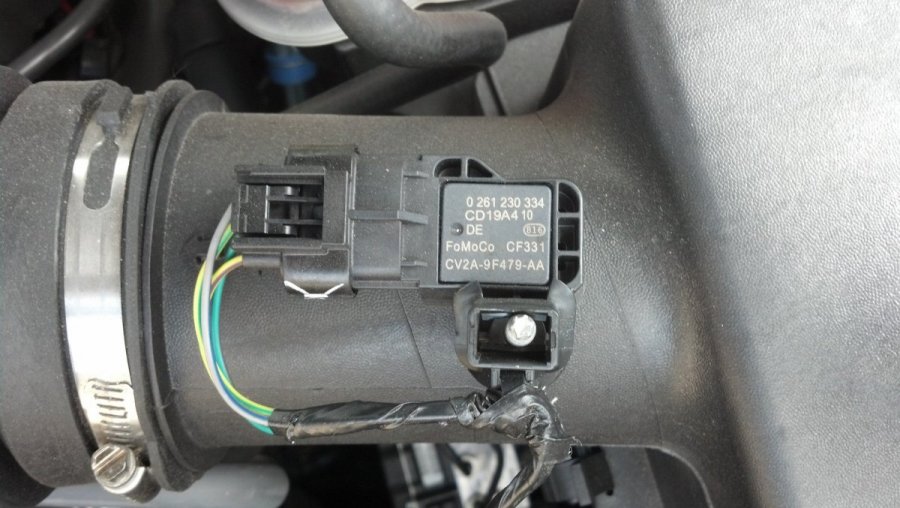

YT90SC
Member-
Posts
1,404 -
Joined
-
Last visited
-
Days Won
3
Content Type
Profiles
Forums
Gallery
Downloads
Store
Everything posted by YT90SC
-

Ranger gets Ford Performance boost
YT90SC replied to blwnsmoke's topic in Ford Motor Company Discussion Forum
-

Ranger gets Ford Performance boost
YT90SC replied to blwnsmoke's topic in Ford Motor Company Discussion Forum
Fairly sure those are TCIPT (TurboCharger Intake Pressure Temp) not MAF. The connector is similar and it is located in the cover of the air cleaner. But I've been wrong before.... -

Ranger gets Ford Performance boost
YT90SC replied to blwnsmoke's topic in Ford Motor Company Discussion Forum
I can't think of any EcoBoost with a MAF at the moment. They use speed/density from Baro/MAP/TCBP which, I imagine is easier to nail down with turbos than MAF. -

Ranger gets Ford Performance boost
YT90SC replied to blwnsmoke's topic in Ford Motor Company Discussion Forum
You are correct. -
In a word: No. Could get a used one, although it may not program properly. Tons available according to sites like Car-part.com
-

Ranger gets Ford Performance boost
YT90SC replied to blwnsmoke's topic in Ford Motor Company Discussion Forum
Bingo. And his filter box even compensates for the sealing material of the filter surround. -

Ranger gets Ford Performance boost
YT90SC replied to blwnsmoke's topic in Ford Motor Company Discussion Forum
Weird. Their website shows the same HARD *RUBBER* surround they have always run. I've replaced a lot of diesel engines and cleaned or replaced a lot of throttle bodies, IAC's and MAF's on gas as a direct result of filtration failures with those products. With manufacturers trying to meet increasingly difficult CAFE, wouldn't they run them from the factory? Does *any* OE? Run what you want, it's your vehicle and I am not dogging you for wanting to better your vehicle. But remember gentlemen, 5 of 6 people who play Russian roulette never had a problem either. CoolScoop, on a side note, some PZEV Focus (NAAO "gen 2" cars) ran the same "lifetime" filter as your Fusion Hybrid and I've seen guys install the serviceable style airbox or fab other filter mounts on the end of the MAF. Those have to be made kind of specifically because the MAF sits so far down in the fender and can easily suck water with an open cone style filter. On the Hybrid because of the Atkinson cycle engine, they also have to have a hydrocarbon catcher, which gen 3 hybrids just have built into the airbox lid. Either way, I *think* I remember that Donaldson built them for Ford, but I could be wrong. -

Ranger gets Ford Performance boost
YT90SC replied to blwnsmoke's topic in Ford Motor Company Discussion Forum
Again, my comments were about their DROP IN filters. Their choice of surround materials simply does not work with Ford's choice in airbox design, especially over time. Plastic air boxes need SOFT foam rubber to seal the perimeter. K&N uses HARD rubber that cannot adequately match the tolerances (or lack of) of the box, or the fact that the plastic eventually warps. They can't use foam rubber because their oil will degrade the soft. Their noisemaker kits usually have cone style filters that clamp on, so they usually don't leak around the perimeter like their drop ins. And, at least they got that going for them. -

Ranger gets Ford Performance boost
YT90SC replied to blwnsmoke's topic in Ford Motor Company Discussion Forum
Without starting a debate about filter material/oiling, or actual filtering ability, my biggest issue with them is most of their filters simply do not seal the air box correctly. They use hard rubber surrounds, not pliable foam rubber like the O.E. then use tape (which degrades) to make the final seal in some instances. With Ford trying to reduce warranty costs, it just surprises me. -

Ranger gets Ford Performance boost
YT90SC replied to blwnsmoke's topic in Ford Motor Company Discussion Forum
Yikes. I find it hard to believe engineering signed off on that. -
Upper, lower or front cover? All common leak areas on a 6.7, and I have seen a lot of uppers misdiagnosed when it is the front cover leaking down near the tee joint to the upper. All can be done in chassis, but for the upper and front cover the trans has to come out. The 6.7 was one of the very last engines that Ford used a gasket and then only the upper pan to block. But I wanna say that was 2013, but don't quote me on that. But even then, the lower was sealant. The 7.3 DIT NEVER had a pan gasket. They leaked literally everywhere else though. The 6.0 and 6.4 had gaskets on the bedplate, but they leaked. Is the repair out of pocket?
-
That kind of thing would be appreciated, man. Seriously.
-
Maybe I should try? It's slow enough I might not get in trouble.
-
I LOATHE both of those styles of valve. They both raise the drain point just a little and will therefore leave more oil in the sump, and have smaller exit holes so any potential debris wont be swept out as easily. They fill with road crap that can be hard to deal with. Often they are dissimilar metals which can be a corrosion issue. None of that is why I HATE them. The biggest sin is they take FOREVER to drain.
-
I think the seats on the GTs were similar though, for what it is worth.
-
Those are someone's aftermarket cover- cover.
-
The green test port is the high side. It should never be cold.
-

Old Ford V8's just wont Die
YT90SC replied to mackinaw's topic in Ford Motor Company Discussion Forum
We had a 300 that got the treatment. With no oil, and only the goop in the crankcase we got tired of listening to it rattle and bang, so we dropped the coolant and stuck bricked the accelerator. It got hot and shut down. Refired when it cooled and endured the process again a couple more times. Nothing we killed ran as long as the sixes. -
If you ever drove one, you wouldn't be saying whooo hoo... 0-60? Maybe.
-
Why 93 specifically? They were essentially the same from 92 to 96. The later trucks getting OBD2 "lite", MAF's and driver's airbags. The six itself was pretty reliable. Typical sixes weep oil from the valve cover, lifter cover and pan. They need tune ups every 30k or so, even if you use "100k mile" plugs. Just do Motorcraft coppers and gap them properly. They run the best and last about as long. There is NO gain from whiz-bang wires. Run Motorcraft if available. IF it has ever been overheated, the long head on the six can crack. Use a 194 degree t-stat, not the shitty 180s or 160s. The PCM sees it as warmup mode and will throw more fuel at it. TFI Ignition modules were an issue for ANY Ford of that era. With 25 year old engine controls, be prepared for failures. Be sure to buy good quality replacements (Motorcraft if possible) as a lot of aftermarket parts are VERY sub standard. If it is a dual fuel tank, it can have cross flow issues, but they are not hard to diagnose if you know what you are doing. A lot of PCM's are showing their age. Be sure to remove it and take the cover off to see if the Capacitors are leaking. IF they are and it still runs ok, you can have about anyone who can solder install new ones. The E4OD auto was a pile Needs aftermarket help to make it reliable and tolerable as a daily. T/R sensors are an issue. The C6 was better, but only 3 speed. There were two 5 speeds. The ZF5 and the M5OD. Both could have issues with the slave cylinder. The M5OD's reverse ratio was REALLY high. Auto hublocks are turds and should be converted to manuals ASAP. Lots of "kits" to do so. If you live in a rust belt state, be sure to check the small bolts that hold the bumper to the brackets. NOT the brackets to the frame. It is not fun to drive over your own bumper when they rust off.
-
Odd. I checked the date on the article expecting it to be a day earlier.
-
"2375" is the WRONG number, as it is "19-2375". TSB 19-2375 has been superseded to 20-2100, which added flex plate replacement along with the short block. The causal part still remains 6009 and will be covered by powertrain and most ESP coverages with powertrain options. Still needs to be verified by specific VIN though.
-

Yet another 5.4 motor issue question
YT90SC replied to XanderMish's topic in Ford Motor Company Discussion Forum
A coil induced miss will first start out, under load on the road, usually when lugging before a downshift. (Which is usually mistaken as a transmission issue) Sometimes it will jump straight to a constant miss and skip the slow death. His is a light tip in during parking lot maneuvers. -

Yet another 5.4 motor issue question
YT90SC replied to XanderMish's topic in Ford Motor Company Discussion Forum
You need to have the oil pressure checked HOT idle. I mean REALLY hot. It must be a minimum 15 psi, HOT, in gear. The 5.4 is oil pressure HUNGRY. Or, more specifically, the VCT's phasers are. The early 3 valves came with VCT solenoids that allowed the phaser to work down to a minimum pressure (hot idle) of 20 psi. There is a revised solenoid (you will need 2) and PCM reprogram that allows it down to 15 psi. ALL aftermarket solenoids I have seen are the early design and will not control the phaser at 15 psi. IF it is below 15 PSI, it will require surgery. The next step is to remove the valve covers and check the cam caps. Some marking and scoring is normal, especially for your mileage. If the caps are ok, get a Melling MH360HV oil pump, it provides 20% more flow and an overall better design. Yours *will* be worn, given the mileage and the added flow will help maintain that hot idle pressure. The gaskets on the chain tensioners always fail and help bleed precious pressure so replace them and any guides that are broken when the timing cover is off. IF the cam caps are scored badly you will need a reman engine. Don't even bother with used, you will just buy someone else's headache. -
Because gasoline evaporates at the same rate in bikes as it does in cars- maybe faster due to the tank being in the sun all the time. Evaporative emissions are a HUGE problem for anything that burns gasoline. Add to that, bikes have VERY dirty tailpipes even when carbs are tuned right. Pass a bike, follow a bike... you can smell them even the open air. I believe Mythbusters even did a show on this.




